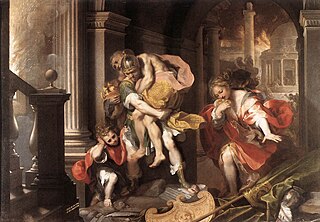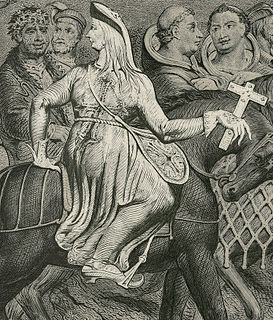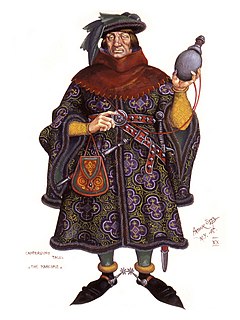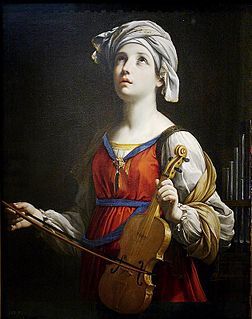
In Greco-Roman mythology, Aeneas was a Trojan hero, the son of the Trojan prince Anchises and the Greek goddess Aphrodite. His father was a first cousin of King Priam of Troy, making Aeneas a second cousin to Priam's children. He is a character in Greek mythology and is mentioned in Homer's Iliad. Aeneas receives full treatment in Roman mythology, most extensively in Virgil's Aeneid, where he is cast as an ancestor of Romulus and Remus. He became the first true hero of Rome. Snorri Sturluson identifies him with the Norse god Vidarr of the Æsir.

Geoffrey Chaucer was an English poet, author, and civil servant best known for The Canterbury Tales. He has been called the "father of English literature", or, alternatively, the "father of English poetry". He was the first writer to be buried in what has since come to be called Poets' Corner, in Westminster Abbey. Chaucer also gained fame as a philosopher and astronomer, composing the scientific A Treatise on the Astrolabe for his 10-year-old son Lewis. He maintained a career in the civil service as a bureaucrat, courtier, diplomat, and member of parliament.

According to Roman tradition, Lucretia, anglicized as Lucrece, was a noblewoman in ancient Rome, whose rape by Sextus Tarquinius (Tarquin) and subsequent suicide precipitated a rebellion that overthrew the Roman monarchy and led to the transition of Roman government from a kingdom to a republic. The incident kindled the flames of dissatisfaction over the tyrannical methods of Tarquin's father, Lucius Tarquinius Superbus, the last king of Rome. As a result, the prominent families instituted a republic, drove the extensive royal family of Tarquin from Rome, and successfully defended the republic against attempted Etruscan and Latin intervention.

The Aeneid is a Latin epic poem, written by Virgil between 29 and 19 BC, that tells the legendary story of Aeneas, a Trojan who fled the fall of Troy and travelled to Italy, where he became the ancestor of the Romans. It comprises 9,896 lines in dactylic hexameter. The first six of the poem's twelve books tell the story of Aeneas' wanderings from Troy to Italy, and the poem's second half tells of the Trojans' ultimately victorious war upon the Latins, under whose name Aeneas and his Trojan followers are destined to be subsumed.

Alcestis or Alceste, was a princess in Greek mythology, known for her love of her husband. Her life story was told by pseudo-Apollodorus in his Bibliotheca, and a version of her death and return from the dead was also popularized in Euripides's tragedy Alcestis.

Pyramus and Thisbe are a pair of ill-fated lovers whose story forms part of Ovid's Metamorphoses. The story has since been retold by many authors.

The Metamorphoses is an 8 AD Latin narrative poem by the Roman poet Ovid, considered his magnum opus. Comprising 11,995 lines, 15 books and over 250 myths, the poem chronicles the history of the world from its creation to the deification of Julius Caesar within a loose mythico-historical framework.

Dido, also known as Elissa, was the legendary founder and first queen of the Phoenician city-state of Carthage, located in modern Tunisia. Known only through ancient Greek and Roman sources, most of which were written well after Carthage's founding, her historicity remains uncertain. In most accounts, she was the queen of the Phoenician city-state of Tyre who fled tyranny to found her own city in northwest Africa.

The Parlement of Foules, also called the Parlement of Briddes or the Assemble of Foules, is a poem by Geoffrey Chaucer (1343?–1400) made up of approximately 700 lines. The poem, which is in the form of a dream vision in rhyme royal stanza, contains one of the earliest references to the idea that St. Valentine's Day is a special day for lovers.

"The Knight's Tale" is the first tale from Geoffrey Chaucer's The Canterbury Tales.

"The Wife of Bath's Tale" is among the best-known of Geoffrey Chaucer's Canterbury Tales. It provides insight into the role of women in the Late Middle Ages and was probably of interest to Chaucer himself, for the character is one of his most developed ones, with her Prologue twice as long as her Tale. He also goes so far as to describe two sets of clothing for her in his General Prologue. She holds her own among the bickering pilgrims, and evidence in the manuscripts suggests that although she was first assigned a different, plainer tale—perhaps the one told by the Shipman—she received her present tale as her significance increased. She calls herself both Alyson and Alys in the prologue, but to confuse matters these are also the names of her 'gossib', whom she mentions several times, as well as many female characters throughout The Canterbury Tales.

"The Pardoner's Tale" is one of The Canterbury Tales by Geoffrey Chaucer. In the order of the Tales, it comes after The Physician's Tale and before The Shipman's Tale; it is prompted by the Host's desire to hear something positive after the physician's depressing tale. The Pardoner initiates his Prologue—briefly accounting his methods of swindling people—and then proceeds to tell a moral tale.

"Star-crossed" or "star-crossed lovers" is a phrase describing a pair of lovers whose relationship is often thwarted by outside forces. The term encompasses other meanings, but originally means the pairing is being "thwarted by a malign star" or that the stars are working against the relationship. Astrological in origin, the phrase stems from the belief that the positions of the stars ruled over people's fates, and is best known from the play Romeo and Juliet by the Elizabethan playwright William Shakespeare. Such pairings are often said to be doomed from the start.

"The Manciple's Tale" is part of Geoffrey Chaucer's The Canterbury Tales. It tends to appear near the end of most manuscripts of the poem, and the prologue to the final tale, "The Parson's Tale", makes it clear it was intended as the penultimate story in the collection. The Manciple, a purchasing agent for a law court, tells a fable about Phoebus Apollo and his pet crow, which is both an etiological myth explaining the crow's black feathers, and a moralistic injunction against gossip.

"The Second Nun's Tale", written in late Middle English, is part of Geoffrey Chaucer's The Canterbury Tales. Narrated by a nun who remains unnamed, it is a hagiography of the life of Saint Cecilia.
Erec and Enide is the first of Chrétien de Troyes' five romance poems, completed around 1170. It is one of three completed works by the author. Erec and Enide tells the story of the marriage of the titular characters, as well as the journey they go on to restore Erec's reputation as a knight after he remains inactive for too long. Consisting of about 7000 lines of Old French, the poem is one of the earliest known Arthurian romances in any language, predated only by the Welsh prose narrative Culhwch and Olwen.
The House of Fame is a Middle English poem by Geoffrey Chaucer, probably written between 1374 and 1385, making it one of his earlier works. It was most likely written after The Book of the Duchess, but its chronological relation to Chaucer's other early poems is uncertain.

The Wedding of Sir Gawain and Dame Ragnelle is a 15th-century English poem, one of several versions of the "loathly lady" story popular during the Middle Ages. An earlier version of the story appears as "The Wyfe of Bayths Tale" in Geoffrey Chaucer's The Canterbury Tales, and the later ballad "The Marriage of Sir Gawain" is essentially a retelling, though its relationship to the medieval poem is uncertain. The author's name is not known, but similarities to Le Morte d'Arthur have led to the suggestion that the poem may have been written by Sir Thomas Malory.

Le Roman d'Enéas is a romance of Medieval French literature, dating to ca. 1160. It is written in French octosyllabic couplets totaling a little over 10,000 lines. Its subject matter is the tale of Aeneas, based on Virgil's Aeneid. It is one of the three important Romans d'Antiquité of this period; the other two are the Roman de Thèbes (anonymous) and the Roman de Troie of Benoît de Sainte-Maure.
Eneide is a seven-episode 1971–1972 Italian television drama, adapted by Franco Rossi from Virgil's epic poem the Aeneid. It stars Giulio Brogi as Aeneas and Olga Karlatos as Dido, and also stars Alessandro Haber, Andrea Giordana and Marilù Tolo. RAI originally broadcast the hour-long episodes from 19 December 1971 to 30 January 1972. A shorter theatrical version was released in 1974 as Le avventure di Enea.

















